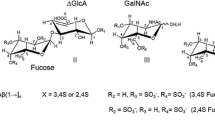Summary
A complete assignment of the13C and1H NMR signals of amylose dissolved in dimethylsulfoxide was achieved using two-dimensional H-H and C-H correlated spectroscopy and deuterium exchange. The same methods together with an INEPT experiment provided the assignments of the1H and13C NMR signals of the amylose type glucan units, the branch end glucan fragments, and a few assignments of nuclei within the branching glucan units of amylopectin dissolved in dimethylsulfoxide. From these assignments and from the integration of pertinent proton signals the branching degrees of amylose and amylopectin were derived to amount to 3.9 and 8–9%.
Zusammenfassung
Die vollständige Zuordnung der13C- und1H-NMR-Signale von in Dimethylsulfoxid gelöster Amylose konnte mit Hilfe zweidimensionaler H-H- und C-H-Korrelationsspektroskopie und Deuteriumaustausch erzielt werden. Die gleichen Methoden sowie ein INEPT-Experiment ermöglichten auch die Zuordnung der13C- und1H-NMR-Signale der amylosischen Glucaneinheiten, der Verzweigungsendfragmente und einzelner Kerne im Bereich der Verzweigungsstellen von in Dimethylsulfoxid gelöstem Amylopektin. Aus diesen Zuordnungen und der Integration entsprechender Protonensignale konnte ein Verzweigungsgrad von Amylose und Amylopektin von 3.9 und 8–9% abgeleitet werden.
Similar content being viewed by others
References
Tegge G (1984) Stärke. Behr's Verlag, Hamburg;
Galliard T (1987) Starch: Properties and Potential. Wiley, Chichester
Eggersdorfer M, Warwel S, Wulff G (1994) Nachwachsende Rohstoffe. Verlag Chemie, Weinheim
Falk H, Micura R, Stanek M, Wutka R (1996) Starch/Stärke48: 344
Falk H, Stanek M, Wutka R (1997) Starch/Stärke49 (in print)
e. g. Newkome GR, Moorefield CN, Vögtle F (1996) Dendritic Molecules. Verlag Chemie, Weinheim. It should be noted that in fact amylopectin is one of the true dendritic molecules since it is irregularly and more or less fractally branched like a tree (from which the word dendrimer has been actually derived). Its backbone closely resembles the stem of a tree, and moreover, because of the nature of its building blocks, it is chiral like a tree.
Kalinowski S, Berer S, Braun S (1984) C-13 Kernresonanzspektroskopie. Thieme, Stuttgart
Galliard T, Bowler P (1987) Ref. [1b]: 55
Davies AL, Loue ED, Keeler J, Moskau D, Lohmann J (1991) J Magn Reson94: 637
Kay LE (1992) J Am Chem Soc114: 10663
Author information
Authors and Affiliations
Rights and permissions
About this article
Cite this article
Falk, H., Stanek, M. Two-dimensional1H and13C NMR spectroscopy and the structural aspects of amylose and amylopectin. Monatsh Chem 128, 777–784 (1997). https://doi.org/10.1007/BF00807088
Received:
Accepted:
Issue Date:
DOI: https://doi.org/10.1007/BF00807088




